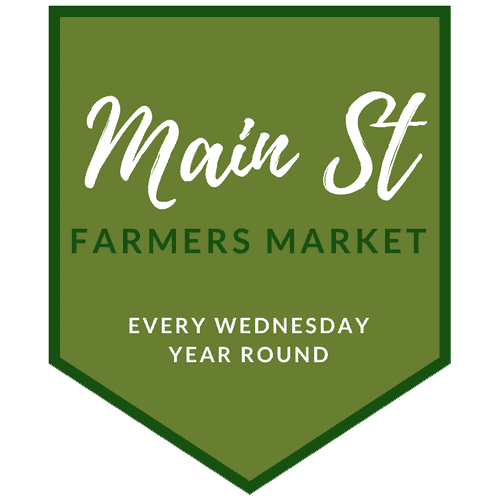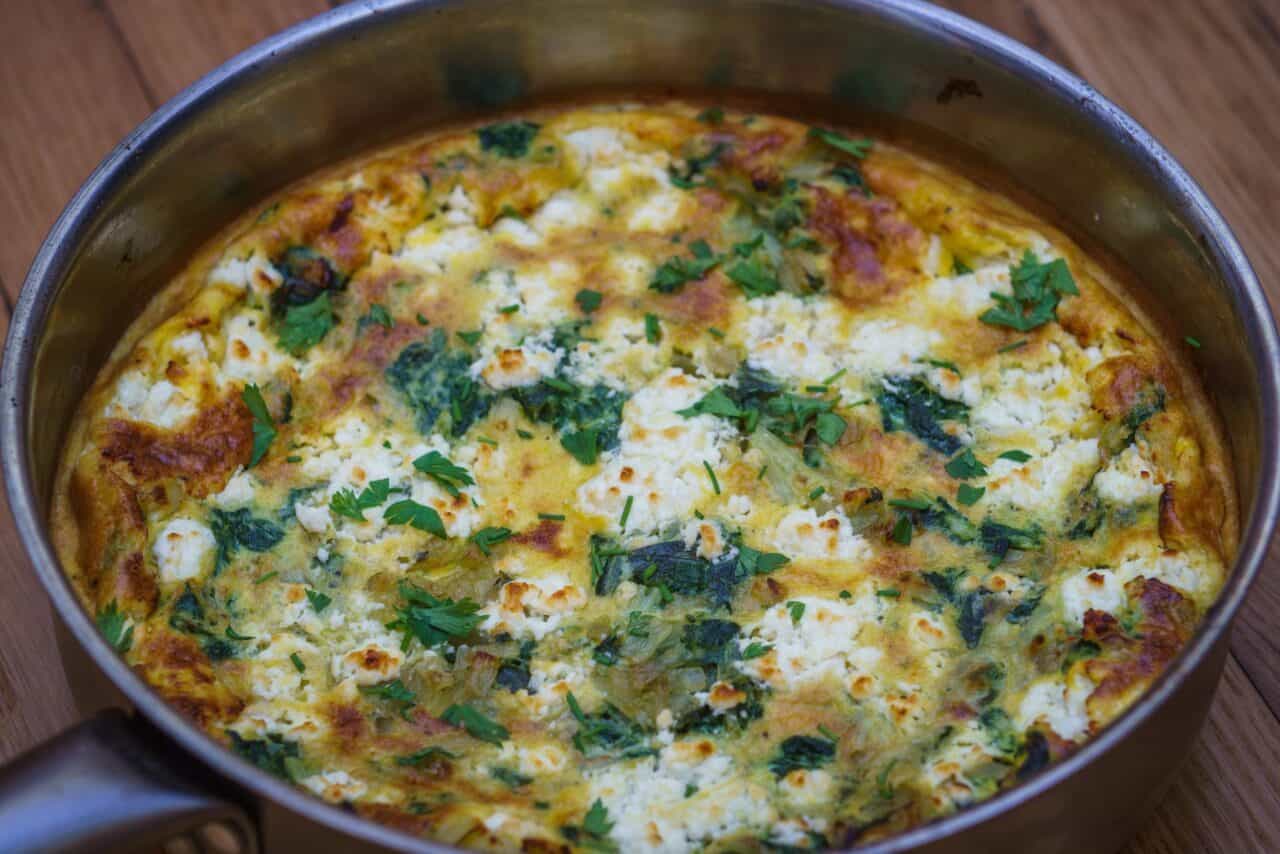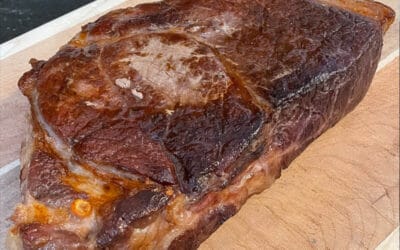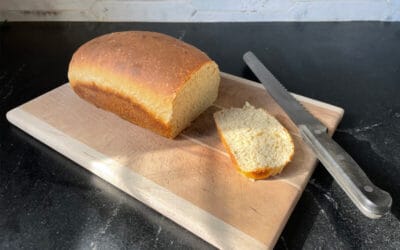Frittata is a great dish to make with holiday leftovers and I can nearly make one in my sleep. I like trying new things, though, and this recipe for Kale and Goat Cheese Frittata was an opportunity to expand my frittata repertoire.
As long as you are not allergic, or eating a vegan diet, eggs are a marvelous food source. They are a complete source of protein and good source of many vitamins and minerals. Hens that are pasture raised have an even higher level of nutrition than those raised conventionally. Eggs are also an excellent value, even at prices that are perhaps higher than you may be used to at the grocery store.
One thing to be careful about with market eggs, at least for certain recipes, is size. If it’s a new to you recipe, or one whose structure is dependent on eggs (for instance, a cake) I advise weighing your eggs. Most recipes use large eggs and the weight range for large eggs is 2-2.25 oz. When I was making this recipe I decided to weigh my eggs, despite it not being crucial for the recipe, and found I only needed 9 eggs instead of ten! So weighing them can save you money as well as the final product.
Another thing to keep in mind is availability. It can vary at the market from week to week. The dark days of winter and the hot days in summer are two times that egg production can suffer but availability does not always follow logic or weather. If you have refrigerator room stock up when your farmer has them to tide you over weeks that they are not available. Although I have heard that eggs are safe up to six months refrigerated the narrower 4-6 weeks recommended by most sources is plenty for most people. If you need more time or space cracking the eggs and freezing them keeps them for up to a year.
As I mentioned above, frittatas are great for using up leftovers. Cooked, especially roasted, veggies; meats; and cheeses are all good for flavoring your frittata and filling out your meal. Generally at our house we think that a frittata must include potatoes. I wasn’t sure if there would be a revolt since this one didn’t! I played it safe and made baked hash browns (recipe in a future post). Although the hash browns were appreciated I did not hear any comments or complaints about potatoes missing in this dish, either.
Another unusual thing for us in a frittata is the inclusion of milk. We use milk and/or cream in quiche but not in frittata. A half cup is just enough to make it a lighter, fluffier frittata than one made only with egg. Feel free to substitute your favorite non-dairy milk, replace with another egg, or leave it out altogether.
We usually use hard cheese to top our frittata, so goat cheese was an interesting change of pace. My family members are big fans of goat cheese, too, so they were very excited to see it topping their slices. When I was sprinkling it on top 4oz seemed as if would be too much. I only used about half that and served the rest on the side.
The seasonings were new to us, too. I had never put mustard in a frittata before but when my youngest took a bite she said “It tastes like deviled eggs! In a good way,” so I’ll call that a success. I’m embarrassed to say I completely forgot the dill. Even though it’s not my first choice of herbs (probably why I forgot it) I can see how it would work well with this dish.
Although kale is called for and certainly yummy, other greens will work fine, too. I think arugula or broccoli rabe would be especially good. Just don’t expect all greens to have the same volume as curly kale. Here’s another use for your kitchen scale.
Frittata is thick and full of veggies and has to be cooked carefully to be done all the way through without burning. Our first attempts at frittata were pretty comical as we slid them out on a plate, flipped them over, and slid them back into the pan. Or just flipped them directly into another pan to finish cooking. As you might guess, this could go wrong and get very messy. (I blame Martha, but at least she got us cooking frittata.) The oven is the easiest way to finish off the cooking. However, Real Simple and I part ways slightly on cooking method. After the greens are cooked I take all the vegetables out of the pan and begin cooking the eggs with a little butter. I scramble them a bit as I go, then when a solid bottom layer is firm I turn off the heat on the stove, evenly distribute veggies and cheese, and pop it under the broiler. Why bake for 20-25 minutes when you can broil for five to ten (depending on the size and thickness)?
We don’t have a non-stick skillet that can go in the oven. We use a stainless steel pan instead. The advantages are that it’s dishwasher safe and we can use a knife on it. The disadvantage, of course, is the sticking. I used some butter with the eggs and tried to cook them quickly but not too long. I need to give my cast iron skillet a try as that is well seasoned and may work better. If you use non-stick be sure to use a non metal spoon or spatula for scooping out your supper.
Kale and Goat Cheese Frittata
From Real Simple October 2016
Ingredients:
1 tablespoon extra-virgin olive oil
1 cup chopped yellow onion (from 1 medium onion)
4 cups chopped curly kale (about 3½ oz.)
10 large eggs
½ cup whole milk
2 tablespoons Dijon mustard
1¼ teaspoons kosher salt
½ teaspoon black pepper
4 ounce (1 cup) goat cheese, crumbled
1 tablespoon fresh dill leaves
Directions:
- Preheat oven to 400°F with the rack in the upper third of oven. Heat the oil in a 10-inch ovenproof nonstick skillet over medium-high. Add the onion; cook, stirring often, until soft and beginning to brown, about 6 minutes. Add the kale; cook, stirring often, until slightly softened, about 2 minutes. Reduce heat to medium.
- Whisk together the eggs, milk, mustard, salt, and pepper in a large bowl; pour over the vegetables in the skillet. Cook until the edges are just beginning to set, about 1 minute. Top evenly with the cheese. Bake in oven until set, 15 to 20 minutes. Top with the dill.






0 Comments